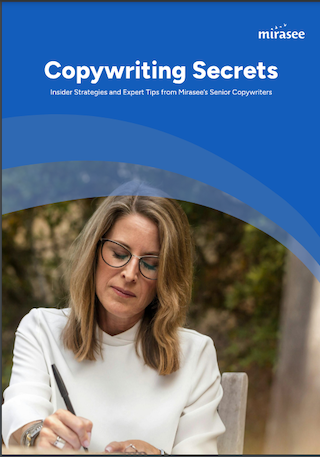10 Tried-and-Tested Copywriting Formulas (& Examples)
Andrew Folkler
Copywriting is an art.
And, like all art forms, there is vast space for creativity and innovation. On the flip side, there is equal room for structure and frameworks.
As you grow your copywriting skills, you will learn where you can push the boundaries of copywriting to attract your audience in unique ways. As the famous painter Pablo Picasso once said, “Learn the rules like a pro so that you can break them like an artist.”
On the other hand, if you are just starting, copywriting formulas can be a fast track to learning how to write compelling copy.
This article will teach you ten of the industry’s most famous tried-and-tested copywriting formulas. You will also learn how to apply them in your own marketing campaigns and how others have created variations of existing formulas to fit their needs. To drive home these copywriting formulas, you will see them all in action in actual marketing campaigns.
So roll up your sleeves, and let’s dive right in!
The Top 10 Copywriting Formulas (+ Examples)
1. Before-After-Bridge (BAB)
Before-After-Bridge is often used to create a sharp contrast between the current pain or problem the target audience is experiencing and the transformation within their grasp. By putting these two polarities next to each other, you can show the reader how they can achieve their desires through your product or service.
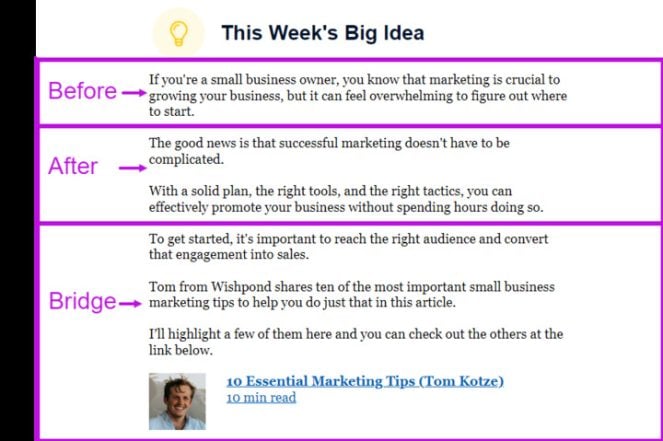
In this example, we can see that the reader is struggling with marketing their small business. They don’t know where to start and are afraid of spending thousands of dollars trying to figure it out through trial and error.
This feeling is sharply contrasted with the idea of the business owner they could be. They could promote their business with little time or effort if they had the right tools, tactics, and plans.
That is when the offer is injected. In this case, it is a list of marketing tips to get them started.
2. Problem, Agitate, Solve (PAS)
The Problem-Agitate-Solve framework is one of the most common frameworks in copywriting. This copywriting formula aims to highlight your understanding of your readers’ current struggle. When the reader feels you understand their problems, you can build credibility with them.
This leads to the next stage, agitate. Many people will avoid taking action for a multitude of reasons. Some people are afraid of the solution failing them. Others don’t even know a solution exists for their problem. As a result, some people would rather sit tight and do nothing while they cope with their challenges. The agitation stage highlights the pains even more. You can share the consequences of inaction and build a desire for change.
That is when you reel them in with your solution. Now the reader knows you understand the full depth of their challenge and believe you are experienced enough in solving that problem to trust your solution.
Here is an example from an email I received from the Coaches Console.
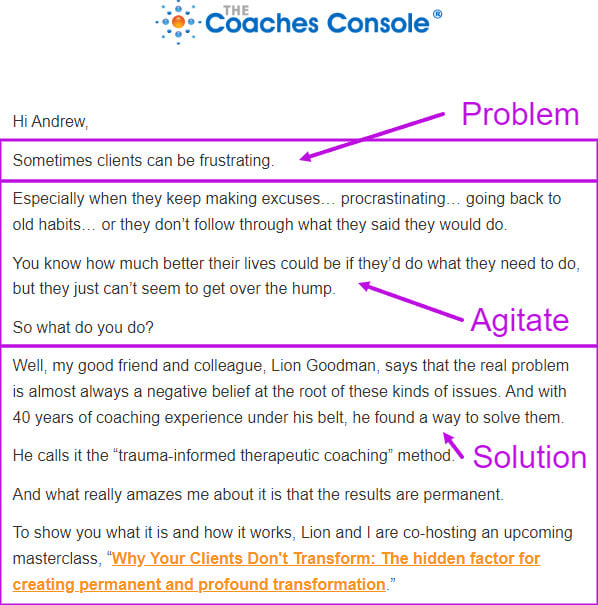
The problem is clearly stated – coaches struggle with frustrating clients. But what kind of clients are frustrating? In the agitation stage, it is revealed that frustrating clients are the ones who do not follow through after their coaching sessions. If the client doesn’t follow through, then they remain stuck. Both parties are exasperated, and there seems to be a tug-of-war between the coach and the client.
That is when the solution is revealed, a masterclass to address this exact problem. The reader is encouraged to sign up and attend the masterclass to learn from the depth of experience shared by the hosts.
Variation of PAS: Problem, Agitate, Solve, Transformation, Offer, Response (PASTOR)
Remember when I mentioned that once you know the rules thoroughly, you will be able to break them in creative ways? Here is a variation of the PAS formula: PASTOR.
The major difference lies in the expansion of the formula to include transformation, the offer, and a target action that the reader needs to take.
Let’s revisit the Coaches Console email above, but read the whole thing this time.
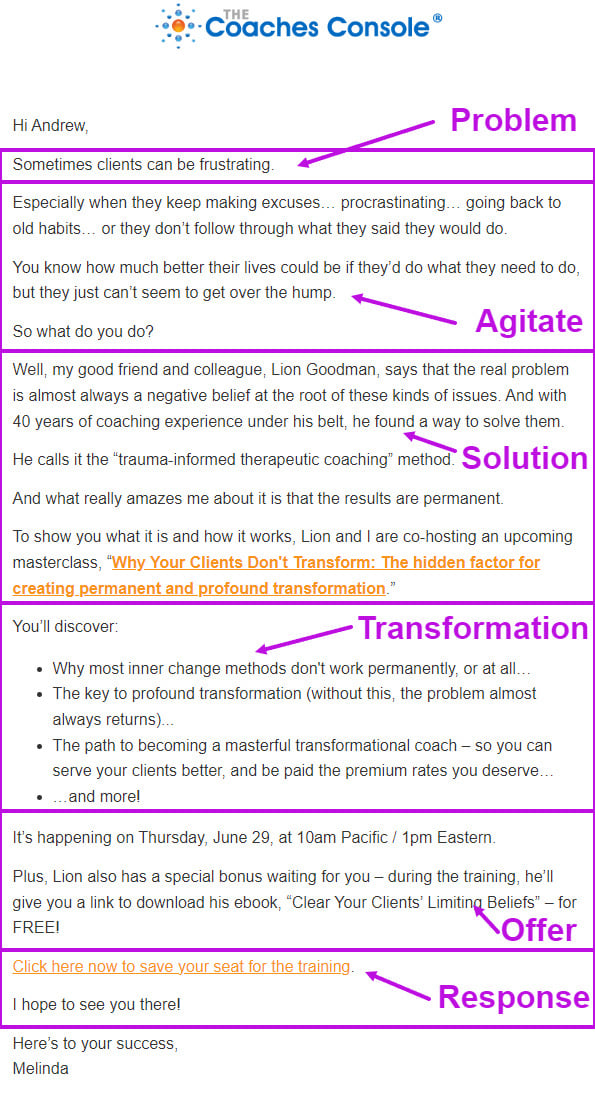
One of the first things you notice is the email builds upon the solution by showing the reader the transformation they can expect. They might have thought, “What will I learn in this masterclass? Will it even help me?”
Now they will read this section and know exactly what they are getting. They will learn techniques to help them create transformations for their clients more effectively. This leads to the offer. In this case, the offer is the masterclass itself, but notice the bonus ebook that is included to make it even more enticing.
Finally, the reader is strongly encouraged to sign up for the masterclass. Instead of a bland call to action like, “Sign up now,” it says, “Click here to save your seat for the training.”
3. Features-Advantages-Benefits (FAB)
Features-Advantages-Benefits is a great three-part copywriting formula that works well for products, especially in the e-commerce space.
Let’s say you are selling a computer to online gamers. A feature you might promote would be your state-of-the-art computer parts with 32 GB of RAM. Now someone not technically savvy would see that and say, “What does 32 GB of RAM mean?”
This is where you transition into the advantages. The average buyer will not need to know that RAM refers to computer memory. What is more relevant to them is that higher RAM means their computer can run more programs at the same time.
But what is the benefit of running more programs at the same time? This is where your copy shifts to explain how high RAM enables your user to record themselves playing a fast-paced online game while streaming it online without fear of the computer crashing.
Let’s look at a live example from an email I received from Linda Claire Puig.

I love running a business. And I love having freedom over my time.
That’s why I was able to spend most of last month exploring Croatia while coaching and producing a podcast. (That’s where I snapped this beauty on the right!)
And one of the keys to having a business that gives you more freedom is leveraging your time. Because while there might be 57 things that have to get done in your business—YOU don’t have to be the one doing all 57!
Sometimes, it makes more sense to outsource. That way, you can stay in your zone of genius, doing what you love, AND you can protect those nice, open spaces on your calendar.
And that’s why I wanted to let you know about what Pat Henseler, the CEO of Emphatic, is doing…
Pat has a way to basically outsource your social media marketing, and it’s very affordable. His method grows your social media presence quickly and attracts more clients for your business, while requiring almost zero time and effort from you.
And right now, you can see for yourself how it works, because Pat’s offering a 7-day test drive of the system.
During the test drive, you’ll get custom posts written for your business and posted for you. These posts are created by real human writers—not AI—and they’re designed to position you as an authority and capture the attention of your best prospects, so they’ll want to become your clients.
And on top of that…if you sign up before tonight at midnight, Pacific, you’ll get nearly $5,000 worth of additional bonuses. See the full bonus package here.
This is a chance to see this system for yourself, and see the results for yourself. And if you decide to stick around after the test drive is over, you’ll get 30 custom social media posts per month—posted for you—and at 25% off the regular monthly price.
All you have to do is claim your 7-day test drive before TONIGHT (June 23) at midnight, Pacific.
Let me know how it goes!
To your brilliant success,
Linda Claire Puig
Right off the bat, Linda talks about one of the biggest goals of any starting entrepreneur – the ability to travel and take your work with you.
What is cleverly done here is the feature is presented as a promise. As you continue reading you learn that one of the advantages of building a business is that you don’t need to be the one doing everything. This leads to the done-for-you offer of Emphatic.
While she describes the offer’s benefits, she is tying it all with the central promise, the freedom to travel and take your work with you.
4. The 4 Cs
The 4 Cs are Clear, Concise, Compelling, and Credible.
The 4 Cs are pretty straightforward. Your copy should be clear and easy to understand. This means you will want to target a 5th-grade reading level and use a conversational tone.
Your copy must be concise, so trim out any unnecessary fluff. When sharing the benefits, make them compelling enough so your reader will be motivated to take action.
And finally, build credibility through your understanding of the core problem, use of social proof, and rapport building throughout the copy.
Here is a live example.
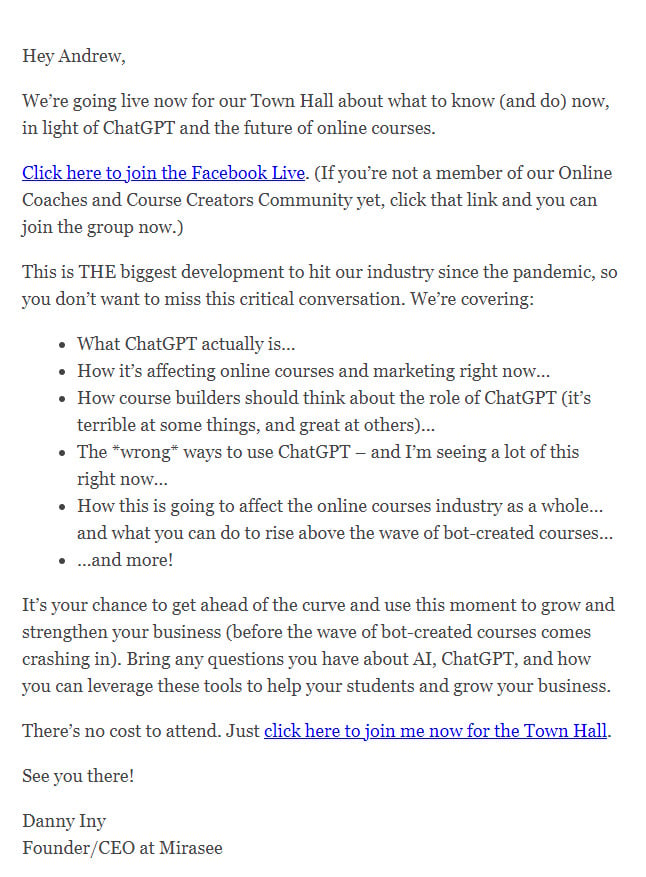
In this example, you will see that Danny gets straight to the point with zero fluff. AI is changing the online landscape and online course creators need to get ahead before the technology advances too much.
To make the town hall meeting enticing, he clearly and concisely explains how it will help business owners stay informed about AI. These benefits make the meeting compelling, especially since there is no cost to tune in.
You might wonder, where is the credibility component since there is no social proof? The credibility part is subtle here. Since readers have probably heard about AI in the news, they will be filled with all kinds of questions. How will it affect online courses? Some people may have already read information about things like AI copywriting.
Since Danny is hosting a town hall meeting on this new topic, it creates the feeling that he knows more about it and is ready to share it.
5. Attention-Interest-Desire-Action (AIDA)
One of the most popular acronyms in marketing, AIDA, has been around since 1898 when Elias St. Elmo Lewis was trying to distill the steps of sales into its basic components.
The first section is attention. This is where you start with a solid hook to catch the attention of your readers so they will continue to read the rest of your copy.
Once you have their attention, you will need to build interest. Discuss a problem or challenge they are having and how you know how to solve it.
Now that you have their attention and interest, you will begin presenting your offer. In this stage, you must build a desire for the product or service you are offering.
Once your reader is primed and ready to purchase your product or service, you push them to take action. Your call to action should be one singular task: book a call, buy a product, or register for an event (via a registration form for event).
Here is an example of the AIDA framework in action.
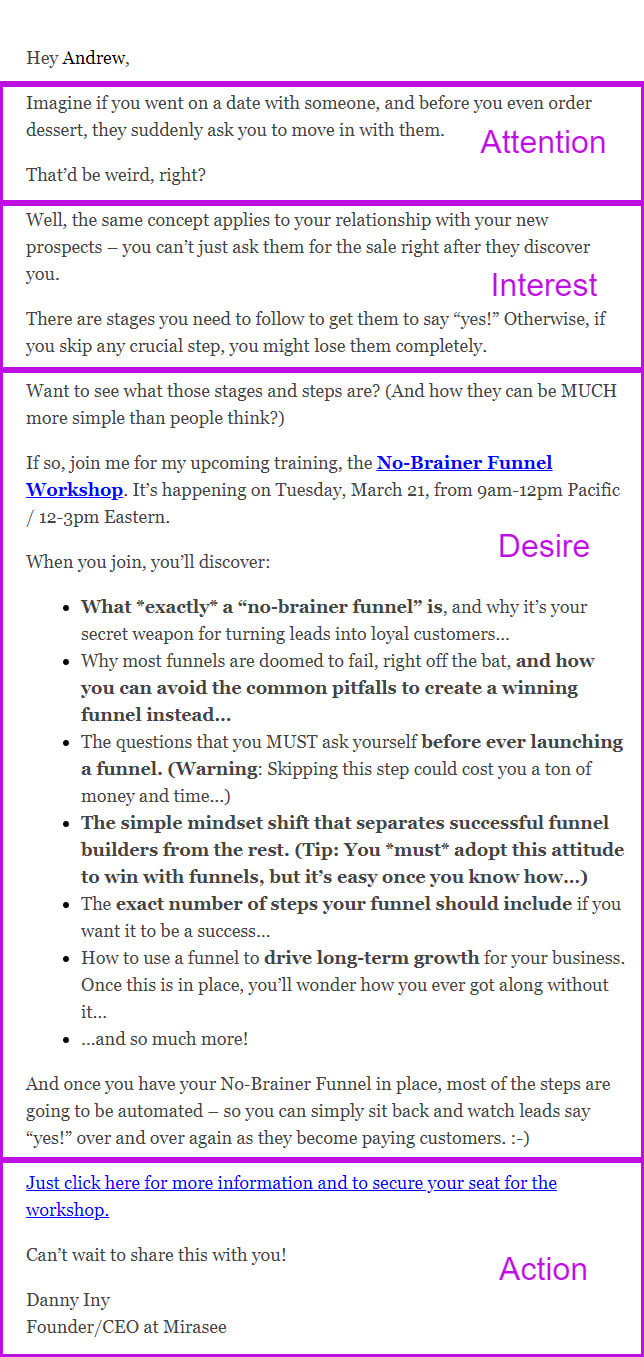
The hook is a funny scenario – what would you say if someone asked you to move in with them during the first date. This immediately grabs your attention and makes you think, “What is this going to be about?”
As you dig deeper into the email, you discover that some business owners move too quickly with their prospects! Now the pieces are starting to come together. So how does a business owner properly build a relationship with their prospects?
In the desire section, this question is answered through the promotion of a workshop event. Danny explains all the benefits of the workshop, ultimately leading to the final call to action to register for the event.
Variations: AIDCA ,IDCA
There are many variations of the AIDA framework but two of the most popular variations are AIDCA and IDCA.
In AIDCA, the C stands for conviction. In this variation, it is insufficient to build desire for the offer. The reader must feel a sense of conviction that the offer will be the shortest pathway to their success.
In IDCA, the attention element is dropped entirely. Instead, the conviction element is added.
Let’s look at the same email from above and see it from the AIDCA lens.
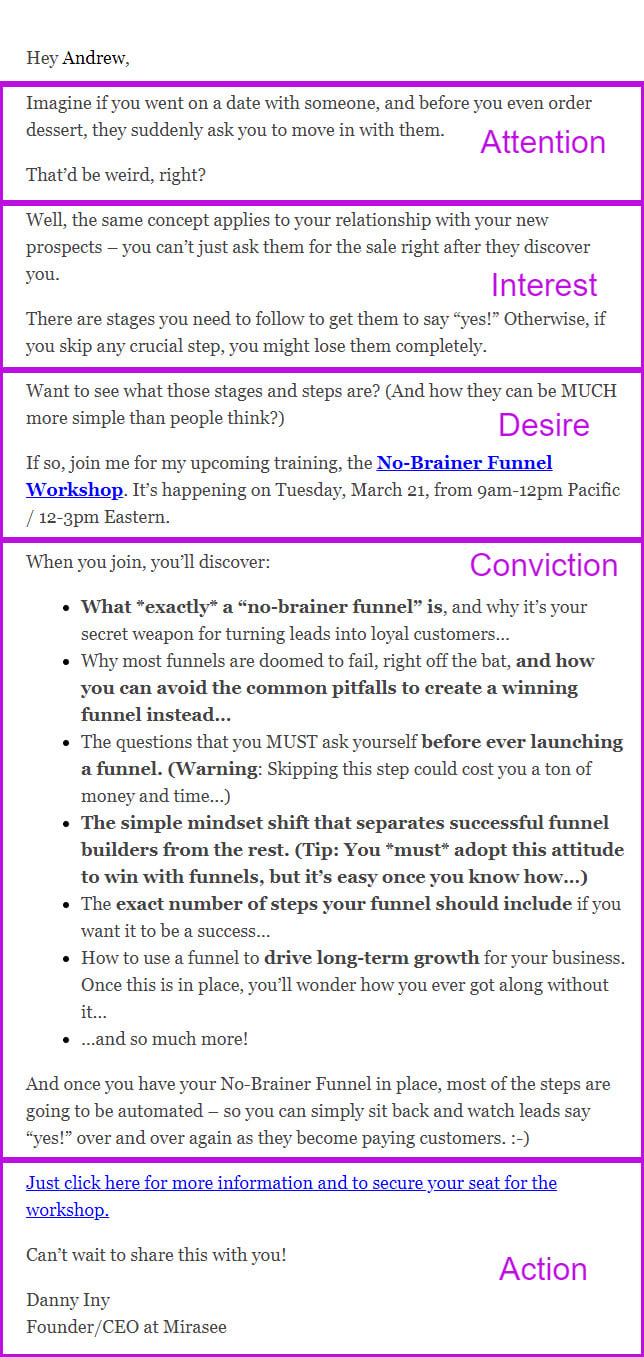
You will see that the conviction part is just the offer’s benefits. In the AIDA version, this is lumped in with the desire section.
What is important to remember is that both copywriting formulas are correct. They both work. What matters is that each component properly conveys the needed information and builds rapport with the reader.
6. The 6+1 Model
The 6+1 Model was developed by our very own Danny Iny. Danny examined the AIDA framework and felt that the action part of the formula was not always guaranteed. You could follow the steps to the tee, but something felt missing.
Danny dived deep into how the AIDA framework could be improved, leading him to create the 6+1 Model.
Danny’s 6+1 copywriting formula works like this.
Step 1: Context
According to Danny Iny, “Context is a critical component of effective messaging. Without it, action likely won’t result, even if you call for it.”
In the AIDA framework, it is implied that attention leads to interest. However, Danny figured out there needed to be a step before attention. That step is context. The reader needs to understand the context of your copy before they will give you their attention.
When they read the first few lines in your copy, will they understand its relevance? If yes, you will have their attention. If not, you need to give them more context.
Step 2: Attention
Now that your reader has relevant context, you might have created a bit of curiosity. However, you still need a hook to grab their attention. This can come in the form of catchy visuals, a compelling headline, or an opening hook that makes them eager to read more.
Step 3: Desire
Once you have someone’s attention, you have to act quickly or risk losing it. Every second, your reader is trying to determine if your copy is worth their time or not.
That is why you immediately talk about the desires of your target audience.
When discussing their desires, paint a clear picture of what that would look like in their life. Think of the feeling when you are hungry and on your way to get something to eat from the kitchen. Your stomach is rumbling. Your mouth starts salivating. And all you can think about is food.
That’s the same feeling you want to build when describing their desires. You want to build a sense of eagerness for a solution to the problem.
Step 4: The Gap
Let’s continue with the example of hunger, but there is a twist. If you don’t eat now, you must wait until after a work meeting or an appointment. That would mean you have to starve for another 1-2 hours!
Step 4 highlights the gap between now and the reader’s choice. If the reader does not take action, they stay in pain. And in some cases, like the food example, the reader could be even more distressed.
Another way you can talk about the gap is to show how easy their desire is to achieve. You can share an innovation, a fascinating statistic, or hard-to-believe truth.
Step 5: Solution
Now that you have highlighted the gap, it is time to reveal the solution. Explain the key benefits of your solution and keep it emotionally relevant to them. Build upon the pain of the gap and show how your solution bridges that pain.
When you tell the reader your solution, it is important to be brief but informative. You want to be brief because you don’t want to overwhelm the reader with details. More details can increase the chances of the reader finding a reason NOT to take action.
Provide only the relevant information about your solution and then transition to Step 6.
Step 6: Call to Action
The final step is to move your reader to take action. Every step before has been building up to this final stage.
Danny says that your call to action should achieve two things.
- Your CTA should identify a single action you want your reader to take. Do not give them a menu of options.
- Explicitly tell your audience to take that action. That means you need to be direct and use active voice.
+1: Build Credibility Along The Way
Now that you know the 6 steps, you might think, “Wait. What is the +1 for?”
The +1 refers to building credibility. This is not a step because it is a critical component in each stage. Building credibility at each step of the process ensures that you keep your readers’ attention and continue moving them through your copy.
Now that you have a clear understanding of the 6+1 copywriting formula let’s see it in action.

Hey Andrew,
When most people think about growing their business with an online course, they imagine generating revenue by enrolling students.
And that definitely works. But did you know you could also launch a course to get more clients?
For example, if you’re a health coach, you could offer a short course that helps people beat fatigue and get more energy in 30 days. It warms up your prospective clients, giving them a great outcome and making them feel they know, like, and trust you enough to sign up for your bigger offers.
And best of all, it’s possible to have a course like that up and running – complete with a sales page and other marketing copy – in less than one day!
I know that sounds like a big promise, so I’d love to show you how it works. To do that, you’re invited to join Abe Crystal (the founder of Ruzuku) and me for a free workshop tomorrow, starting at 10am Pacific / 1pm Eastern.
During the workshop you’ll discover:
- How to build out a complete course in less than a day – including the content and the tech set up.
- The hidden dangers of ChatGPT for course creators. These limitations mean AI could do more harm than good for your course.
- How coaches and consultants can use courses to get a steady stream of clients… and end the feast-or-famine cycle of client work.
- Why thinking, “Can’t ChatGPT do it for me?” could spell disaster for your course, and what to do instead to save time and still create value for your students.
- The Customer Learning Journey that holds the key to increased revenue, stronger engagement, and more referrals for your business.
- The top 3 obstacles to creating online courses, and how to breeze past them and just start making rapid progress…
- How to avoid the tech headaches that come with building a course. This simple shift helps you bust through the tech barrier once and for all.
- The FOUR surefire ways you can make money from an online course. (Most people use just ONE of these methods and miss out on lots of revenue.)
- How to enroll more students and collect payments easily, even if you’ve never done it before.
- The 3 common (but flawed) approaches to building online courses. Avoid these! They ruin many course businesses before they even get off the ground!
- Why ChatGPT is a ticking time bomb for course creators who don’t know how to use it. Plus, see how you can leverage AI tools safely and effectively to support your students and build courses faster.
- How to match your tech to the needs of your clients and their stage in The Customer Learning Journey. Get this right, and you’ll save your clients (and yourself) tons of headaches.
- …and more!
Go here to register for The Fail-Proof Method for Launching Your Online Course… In Less Than a Day.
Abe and I will be sharing our best strategies for using short, focused courses to grow your business… so I really hope you’ll join us!
Danny Iny
Founder/CEO at Mirasee
In the email above, you can easily see how each section could fit into the 6+1 copywriting formula. In the context section, Danny speaks to audiences looking to grow their business with online courses.
Then he grabs their attention by talking about something they likely have never heard of before, an online course that would attract more clients.
All online business owners are interested in getting more clients, leading to the desire section, where he highlights the example of a health coach. The reader can see themselves in the shoes of this proverbial health coach, and they want that transformation for themselves.
That’s when the reader hears about how they could achieve with an online course they could build in a day. The claim is so bold that they must learn how it is possible.
Transition to the solution – a free workshop where the benefits of attending are clearly explained. There are so many that the reader would be silly to miss this!
Finally, in the end, the reader is encouraged to register for the workshop.
7. The 5 Basic Objections
When a person reads your copy, they are going to have objections. What is fascinating is that every objection falls into one or more of these five categories.
- I don’t have enough time.
- I don’t have enough money.
- It won’t work for me.
- I don’t believe you.
- I don’t need it.
These objections arise out of fear. The objections are usually falsehoods we tell ourselves to justify the fears we experience. Your copywriting should tackle as many of these objections as possible. That way, your reader will feel strongly assured that your product or service will provide them with the desired transformation.
Let’s see this in action.
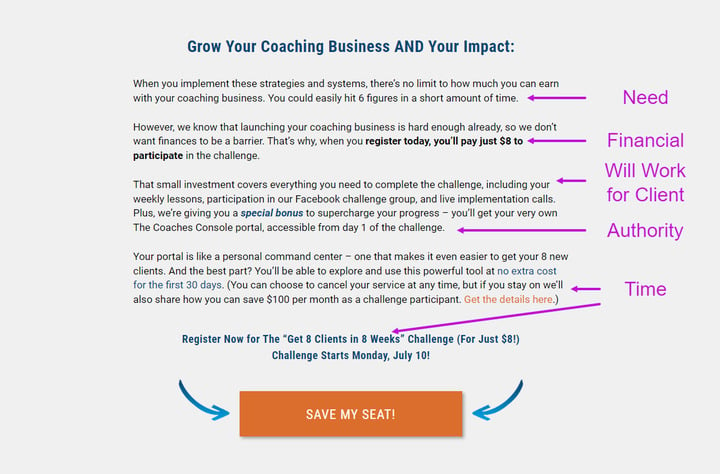
Grow Your Coaching Business AND Your Impact:
When you implement these strategies and systems, there’s no limit to how much you can earn with your coaching business. You could easily hit 6 figures in a short amount of time.
However, we know that launching your coaching business is hard enough already, so we don’t want finances to be a barrier. That’s why, when you register today, you’ll pay just $8 to participate in the challenge.
That small investment covers everything you need to complete the challenge, including your weekly lessons, participation in our Facebook challenge group, and live implementation calls. Plus, we’re giving you a special bonus to supercharge your progress – you’ll get your very own The Coaches Console portal, accessible from day 1 of the challenge.
Your portal is like a personal command center – one that makes it even easier to get your 8 new clients. And the best part? You’ll be able to explore and use this powerful tool at no extra cost for the first 30 days. (You can choose to cancel your service at any time, but if you stay on we’ll also share how you can save $100 per month as a challenge participant. Get the details here.)
Register Now for The “Get 8 Clients in 8 Weeks” Challenge (For Just $8!)
Challenge Starts Monday, July 10!
Right off the bat, the copy addresses the client’s need for the product. The need is expressed via the promised transformation of being a 6-figure online coach.
The next objection that is tackled is the price. With a price of $8, there is a low barrier to entry. Anyone who says they cannot afford the price has bigger problems in their coaching business than the program cost.
To address the objections of the program’s chance of success for the client, the copy reveals the bonus offers to showcase how confident the company is in its offer. This does two things simultaneously. First, it shows the reader how they will be supported throughout the program. And second, it reinforces the authority of the brand.
The final objection is time, explicitly stated in the promise of the offer, “8 Clients in 8 Weeks.” The client knows exactly what is expected of them, and if they cannot commit to 8 weeks, they are likely dealing with bigger issues in their coaching business.
8. The 4 P’s (PPPP)
The 4 P’s or PPPP stands for Picture, Promise, Prove and Push. This versatile copywriting formula works well for copywriting and product descriptions.
One exciting take about this copywriting formula is that Picture or Promise can switch places if it fits your copy better.
Let’s say you start with Promise. Your copywriting can begin with a headline that speaks to your audience’s desired transformation.
For example: “Learn to be a top-tier project manager.”
Then, the Picture section is where you tell a story that the reader can empathize with. The more they see themselves in the story, the stronger the emotional attachment they will have with your solution at the end.
The third section is where you provide logical proof that your solution is the right course of action for your readers. Here is where you include testimonials and the benefits of your offer.
Finally, you push the reader to make a single call to action.
Here is a live example of the 4 Ps.
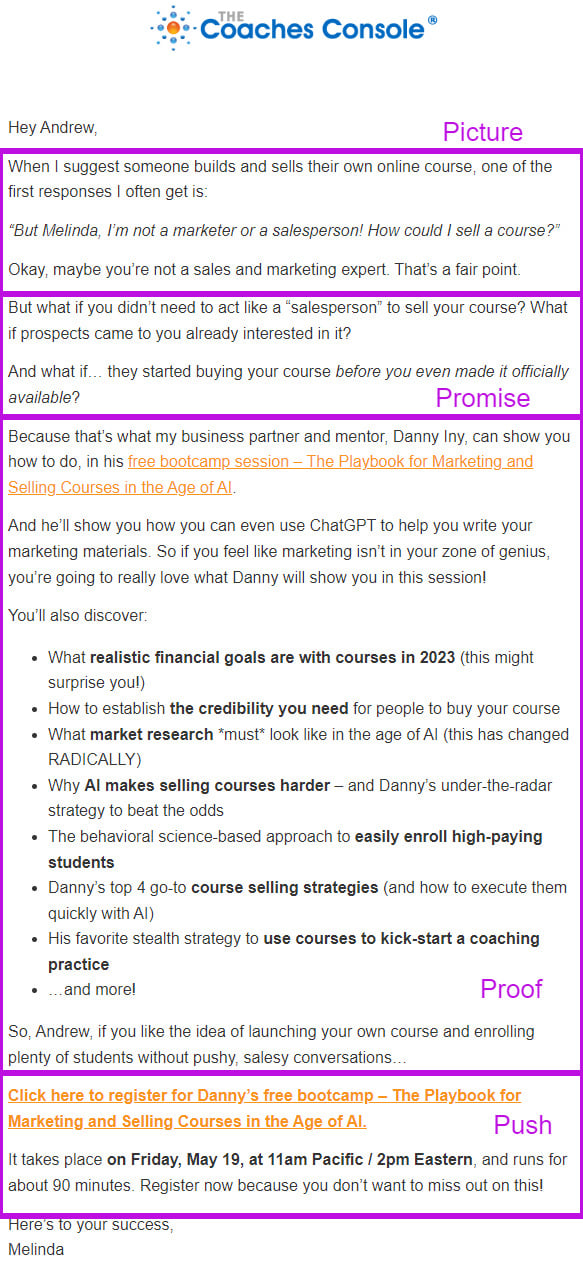
In this example, you can see that Melinda paints a picture of the average coach who does not know much about marketing. That is where she transitions into the promise of being able to sell your online course before it is even officially launched.
Since this email shows Melinda promoting a Mirasee product, her endorsement is an act of social proof. In addition, she shares several benefits that attendees would have if they signed up for the boot camp.
Finally, she pushes readers to attend the boot camp with a strong call to action.
9. The 4 U’s
The 4 U’s are a common copywriting formula used to make a headline or call to action eye-catching. They stand for useful, urgent, unique, and ultra-specific.
Let’s write an example call to action for an online coaching business about productivity.
Join the Productivity Program.
Pretty boring right? Let’s make the line sound more useful.
Join the Productivity Program and get more time back in your day.
It is slightly better, but it is still lacking. Now let’s add some urgency. A great way to do so is to add in scarcity.
Only ten spots left! Join the Productivity Program now and get more time back in your day.
The CTA is improving, but it still sounds generic. Let’s add some spice to it and make it more unique.
Only ten spots left! Join the Productivity Program now and get more time in your day so you can grow your business.
Finally, let’s make this even more specific so that it reaches the exact type of audience you want to sign up for your programs.
Only 10 spots left! Join the CEO Productivity Program now and get 4 hours back in your day so you can grow your business to 6 Figures.
10. The Storytelling Formula
The storytelling copywriting formula has three components: star, story, and solution.
The Star is your main character. This can be your ideal client avatar.
The Story is the events that are occurring in your star’s life. This is where you build up tension with the struggles and frustrations in their journey.
Finally, the solution is where the overarching problem is resolved, and the star can move forward in their journey.
The storytelling formula works well with case studies and testimonials as it builds empathy with the audience. Here is an example.

Hey Andrew,
I recently emailed you about how to get a ticket to Teach Your Gift Live, the event for anyone who wants to launch a winning online course… and ensure that your students get incredible results.
I can give you all kinds of reasons to be there. Like how we’ll give you a proven plan to follow, and 1:1 coaching, so you can confidently move forward and get your online course into the world.
However, sometimes it’s better to let you hear from our past attendees, who were once where you are right now: reading about this event, and wondering whether to attend.
Like Murray Cowell. Murray had been running courses for 10+ years, and although he had a lot of experience, he said, “It doesn’t matter how much you think you know about a subject, there’s always more to learn.”
And that’s why he came to Teach Your Gift Live. After the event, he said:
“[Teach Your Gift Live was] absolutely packed in value … Mirasee is very honest about the work that’s involved [to build an online course] and the results you can expect … And the thing that I find most important … is that the people really, really care about the results you get.”
I love that Murray could feel how much we care about your results and what happens to you after the event. Because I know that so many events end and then just send attendees on their way, feeling lost and overwhelmed about what to do next… so we’ve made sure you’ll have the opposite experience at Teach Your Gift Live.
Here are just a few ways we do that:
- You get to meet with one of our top-tier business coaches, to answer your questions and help you break through your biggest bottleneck.
- We help you personalize your online course roadmap, so you know the right steps to take in the right order… and it’s a roadmap you’ll use throughout your course-building journey.
- We show you how to prioritize your goals and initiatives. That way, instead of wondering what to do once the event ends, the very next morning you’ll wake up knowing your next steps. And you’ll be able to take those steps with confidence and clarity.
So, Andrew, if you’d like to create and launch a successful online course…
…I really hope you join us at Teach Your Gift Live!
It’s all happening online, August 9-11.
One more thing!
When you get your ticket to Teach Your Gift Live NOW, you’ll also receive the complete set of event recordings from Audience Live!
As you probably know, Audience Live will give you a proven framework to quickly build a loyal, engaged audience that wants what you offer. You’ll discover how to pinpoint your ideal audience member, along with what they really want and where to find them. And you’ll discover how to bring them into your world and build a connection with them.
Equipped with these strategies, you’ll be able to build your audience and turn it into a profitable asset for your business.
This is a great complement to Teach Your Gift Live, because while Teach Your Gift Live helps you create and launch a successful online course, Audience Live is how you’ll keep building an eager audience that wants to enroll in your course!
And you’ll get these recordings as a bonus when you reserve your Teach Your Gift Live ticket before midnight (Pacific) on Thursday, April 27.
Click here to register for Teach Your Gift Live – and get your bonus Audience Live recordings.
Andrew, one of the best decisions you can make for your business is picking the right people and the right strategies to bring your course to life. Teach Your Gift Life was designed for this very purpose… and my team and I can’t wait to support you.
So, will we see you there? 🙂
Danny Iny
Founder/CEO at Mirasee
In this email, you can see the “Star” is an entrepreneur who wants to learn more about selling online courses. So where does he go? He signs up for Teach Your Gift Live!
Now this story is quite simple and doesn’t have any stakes. There isn’t a huge plot with many challenges along the way. Instead, the story is meant to be more positive and uplifting. That is why a testimonial is included instead of dramatized copy about the client’s business challenges. Depending on your target audience, you will have to structure your story accordingly.
Finally, you reach the suggested solution where the copy discusses the value attendees will get when they sign up for Teach Your Gift Live.
Put Principles into Practice with These Tried-and-Tested Copywriting Formulas
In this article, you have learned 10 of the most popular copywriting formulas used in the industry. These formulas are potent tools to help you structure your copy to be compelling and engaging.
If you are just starting out in your copywriting journey, take some time to master these formulas. Examine other people’s copy and try to identify the specific frameworks that they used. Copywriting formulas make it easy to outline your work beforehand, and they help you stay on track.
And for seasoned writers, remember that copywriting is an art. As you explore your craft, you will look for opportunities to push the boundaries of what is commonly done so that you can stand out.
So start today and put these copywriting formulas and principles into practice. These formulas will work whether you write social media copywriting, blog content, or even copyediting someone else’s copy. No matter what, keep writing quality content and copy so that you can share your gift with the world.
Elevate Your Copywriting Game!
Discover winning strategies and insider tips for writing words that sell - from Mirasee’s very own expert copywriting team!